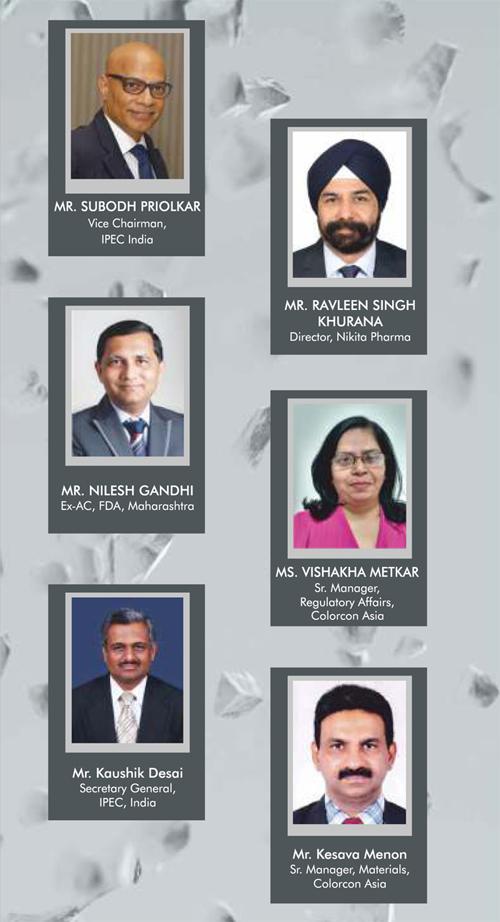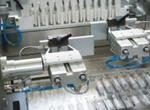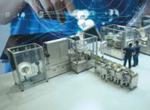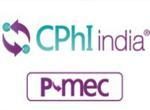Excipients Mitigation Of Supply Chain, & Regulatory Challenges

International Pharmaceutical Excipient Council of India (IPEC India) is a non-profit organization and part of global Federation (IPEC Federation) which comprises five regional bodies America, Europe, Japan, China and India. IPEC India conducted its third webinar of its series for knowledge sharing
The Webinar held on 31st July, 2020 on the topic ‘Excipients: Mitigation of Supply Chain Quality and Regulatory Challenge’. There were more than 400 participants from across the globe viz. Europe, USA, Middle East and Bangladesh. The panellist included Mr. Ajit Singh, Chairman, IPEC India, Mr. Subodh Priolkar- Vice-Chairman IPEC India. Mr. Nilesh Gandhi, Ex-AC, FDA, Maharashtra, Mr. Ravleen Singh Khurana, MD of Nitika Pharma. Ms. Vishakha Metkar, Sr. Manager – Regulatory Affairs, Colorcon Asia & Chairman- Reg. Affairs Committee & Managing Committee Member- IPEC India. Mr. Keshava Menon, Sr. Manager, Materials, Colorcon Asia.
The Webinar focused on the challenges viz. supply chain, quality and regulatory faced by the excipient industry and also how to develop and follow robust global guidelines to mitigate the various challenge.
 Addressing the webinar Mr. Ajit Singh said that pharmaceuticals products cannot achieve its quality and efficacy without excipients. Excipients are yet to get its recognition, but it is the subject that has been understood by the pharmaceutical industry. This is IPEC India’s vision to get due recognition for excipients in India and frame guidelines with the support of the Government as per global standards. We need to be specialized and follow the global cGMP guidelines.
Addressing the webinar Mr. Ajit Singh said that pharmaceuticals products cannot achieve its quality and efficacy without excipients. Excipients are yet to get its recognition, but it is the subject that has been understood by the pharmaceutical industry. This is IPEC India’s vision to get due recognition for excipients in India and frame guidelines with the support of the Government as per global standards. We need to be specialized and follow the global cGMP guidelines.
GMP standards are sufficient for pharma itself. It is time that our pharmacy syllabi cover the subject on excipients. Pharmacy syllabus covering excipients will educate pharmacists from the beginning about the importance of excipients.

MR. SUBODH PRIOLKAR,
Vice Chairman, IPEC India, moderated the Panel Discussion and put forth the following questions on the table for the experts to opine.
Q
What are the challenges faced by the supply chain during the pandemic era and how it has been addressed
The three-element services criteria of supply chain management were hit by this pandemic in India. First the ocean freight, second the air freight and third the road transport. When you look at ocean transport most of the shipping companies in the world operate based on a justified volume, with at the capacity of a ship carrying about from 2000 to25000 containers in a single transit. Sixty percent of the containers come from China, since China is out of business so the sixty percent of volume broken down, and in its absence, it was not economically viable for the shipping companies to operate. Companies had to reduce the frequency of operation to many parts of the world and India is not an exception. In India, most of the shipping companies have skipped or taking berth in the port of JNPT. The reason for discontinuation calling JNPT Port because there was a lot of backlog of containers. This has affected the exports to some extent. There was massive migration of people from cities to villages and as a result, there was a shortage of manpower to handle the loads, truck, trailers and other operating equipment’s.
If we look at air freight the situation is not as severely impacted as compared to ocean freight because there were many passenger aircraft converted into freight carriers. In line with other freight carriers. But in absence of volumes in cargo, the freight charges were tremendously high and almost we had spent almost 100 percent more. It was a tremendous impact on the supply chain concerning air freight cost, but again the situation is slowly coming back to normal. Now we are able to pay around 30% above the standard rates.
The other element of service was road transport. In India, at large scale road transport is used for last-mile deliveries. We had faced the challenges even in road transportation, many of them must have hired a dedicated truck to send the consignments to the customer’s place because of volumes.
Later transporters were willing to carry consolidate goods with engineering as well as with essential and non-essential goods. But here the challenge faced was once they club these commodities together to have operational easiness but they find it difficult to justify at state borders, when the vehicle was at the state border and if that state is under lockdown or containment zone the entry was restricted and at the check post, while inspecting the vehicle, if the inspector finds that both the essential and non-essential goods are combined in the same vehicles. They detain the vehicle. These were the problems faced during lockdown for transportation whether by sea, air, or road.
- Mr. Kesava Menon
Q
One has to require to develop some innovative methods to mitigate these challenges of the supply chain. Have you used any innovative methods?
From my point of view, adapting the innovative method is applicable to everybody. We need to search and identify an alternative port that is conducive for the business whether it is warehousing or for manufacturing. For example, Colorcon Asia has already identified the alternate source of the port. We identified Goa Port, where we have planned the action and placed the orders
- Mr. Kesava Menon
Q
What innovative method took to combat these challenge in Nagpur as all pharmaceutical manufacturers join together?
Yes, we had to face a lot of challenges in COVID that the independent vehicles were charging very high, and the volume was the issue, like what Menon said. So we pharma companies of Nagpur had an association called VDMA (Vidarvha Drug Manufacturing Association). Some of us came together to approach the administration of Nagpur. The collector supported us by giving special permission for that particular vehicle. E-Passes were issued to transport the material to and fro without any restriction. We got some orders to supply for COVID medicines to a pharma company. It was used to make hydroxychloroquine for the U.S market.
- Mr. Ravleen Singh Khurana
Q
During your comments, you talked about the impact of supply because of import restrictions and advisory on China. Is it still on or the situation is improved or what is going to happen because the pharmaceutical industry till today sources a lot of APIs and excipients from China?
The import restriction from China is relaxed to some extent. According to its comprehension, 70 percent of intermediate drug go-between is satisfied by China, and 84 percent of the solar industry is subject to Chinese import, and a large portion of the purchaser gadgets industry in India is again reliant on a Chinese import. The only precaution one can do is file the bill of entry in time and keep up the assessment ready. The wait time will be for the physical examination can lead to delay.
- Mr. Kesava Menon
Q
What type of safety precautions are being taken to ensure the corona infection doesn't happen in manufacturing premises of the pharmaceutical or excipient industry and simultaneously maintaining quality norms with minimum workforce? Do your customers ask you to prove that your goods are corona free probably?
It’s a very big challenge that we are facing in recent times. The safety officer has been put as a corona warrior of the company, and they made SOP’s to tackle this pandemic situation.
We have started with basic things like social distancing, and we have staggered shifts in the laboratory and in manufacturing so that we can reduce the load at a time. In the canteen, we never let the staff use canteen at one time.
We had some innovative things like a hamper consisting of liquid soaps, the Dettol soaps, and sanitizers and were given it to every employee at the time of salary for him and even for his family to use at home.
The masks were procured and were given every day so that employees can use fresh masks. The reuse of masks was not allowed.
The incoming transport vehicle has a high risk while loading and unloading. The vehicle parts where a human can touch were being sanitized before unloading, and before loading, a vehicle was fogged before loading.
The engineering team has installed foot-operated knobs at the bottom of the doors so that they can be operated without human touch. Especially at the washroom and other doors, The sensor taps and foot-operated taps are installed. These are the major precautions undertaken by us.
- Mr. Ravleen Singh Khurana
Q
What are your views on the regulations prevailing in India with respect to excipients? Is there a need for separate guidelines for excipients?
Looking into the definition of ‘drugs’ even in the USFDA 21 CFR under section 201 (g) of FD&C Act, the definition of drugs includes the components which are used in the manufacture of drugs. As far as Indian regulatory provisions are concerned, the excipients are considered as drugs. Section 3(b)(iii) of the Drugs and Cosmetics Act, 1940 specifically provides that components used in the manufacture of drugs are considered ‘drug.’ Thereby, excipients used for the manufacture of medicines are covered under the definition of a drug. In spite of these substances not being active or conventional drugs, it will be considered as drugs under this definition. Therefore, excipients will be regulated as per the provisions under the drugs and cosmetic act and rules. Consequently, licence will be required for the sales and distribution of these excipients. The requirements for standards, GMP, etc. for the manufacture of excipients will be the same that is applicable for API, and the licensee needs to comply with the requirements as amended from time to time.
The object of the regulations and requirements like licensing and Schedule M, etc. is to ensure the safety and quality of the ingredients used for the manufacture of drugs. The excipients shall comply with prescribed standards and should be manufactured in accordance with the requirements laid down.
In case the components/excipients are not used in the manufacture of drugs or are ‘not for medicinal use,’ then said substances would be out of the purview of the definition of a drug. In support of this, there is a provision under schedule K, read with rule 123, which gives exemption from the licensing requirements for such substances. Such exemption is subject to condition, which includes requirement that substance to be labelled as “not for medicinal use”.
- Mr. Nilesh Gandhi
Q
Do every excipient manufacturer in India need to have an FDA manufacturing license?
No, not all manufacturers of such substances need a license. License is required only to those manufacturers of excipient, which are used as a component in the manufacture of the drug. For example, if a manufacturer of Magnesium Stearate does not intend to sell and the substance is not being used in the manufacture of drugs, then, Licence is not required under the Drugs and Cosmetic Act and Rules. But if any excipient substance is used in the manufacture of drugs, whether it remains in the final product or not, then the provisions of the Drugs and Cosmetic Act and Rules will be applicable and will require license for the same.
- Mr. Nilesh Gandhi
Q
Is there any move from Indian Pharma regulatory agencies to have separate regulations for excipients like one for pharmaceuticals and one for excipients?
Sometimes, It may not be possible for large-scale industries catering to the non-pharmaceutical use to go for licensing for a smaller portion being used for manufacture of drugs. But one should understand the main objective of the requirement of licensing and regulations under the Drugs and Cosmetic Act and Rules. The purpose of the requirements is to ensure the safety and quality of the excipients or whatever component goes into the manufacture of drugs. The components going into drugs shall be complying with the prescribed standards, which can be ensured only by its manufacture in accordance with the requirements provided so as to achieve safety of the drugs.
Regarding the requirements of the separate regulations or guidelines or guidance for excipient manufacturers to bring some flexibility to the manufacturers, there are two aspects. One is the mandatory regulatory requirement to ensure the minimum standards, which ensure the safety and standards of the drugs. Secondly, there are some additional requirements or measures for a specific category of excipients in terms of processes, specifications. As per Schedule M the requirements are not specified concerning some of the dosage forms under Part II for requirements of machinery equipment. The Licensing Authority has the discretion to allow some deviations from the general requirement of GMP in manufacturing. The provision is available only pertaining to certain drugs or excipient, for example, medicinal gases, diagnostic reagents, empty gelatin capsules, etc. The requirements will totally depend on the nature of the ingredient, nature of the excipients; the deviations may be allowed with the discretion of the licensing authority. Regarding the process of separate regulatory guidelines for excipients, as per my knowledge, presently, no such steps are being taken to create guidelines. But it is expected that the regulators may issue some guidance in the future.
- Mr. Nilesh Gandhi
Q
What are the issues relating to nitrosamine impurities? What is an impact on excipients, and has it been tackled?
These nitrosamine regulations it comes only for the drug formulations. However, to do the assessments, pharma company would need inputs from the excipient manufacturers whether there are any nitrosating, nitrites, or nitrate type of ingredients in their excipients that could affect the nitrosamines or the NDMA levels in the final product so the excipient manufacturers could provide this information to the pharma companies. The only requirement as of now. IPEC Federation has put in a questionnaire a model for a template for doing an assessment of the nitrosamines and I think that can be used by the excipient manufacturers to do an assessment of their own product and provide this as a ready-made questionnaire to the pharma companies to do their assessments but as of now there is no requirement for recipients to do anything on the nitrosamines unless there is any nitrostatingor nitrate or nitrate ingredients that are there in their products that would affect the pharma or drug product.
- Ms Vishakha Metkar
Q
Do customers ask for the assessment or the statements?
An assessment has to be done as per the guidelines. In Europe, some guidelines are used to assess that template. Every formulation would have some of the other reactions that would trigger these NDMA impurities. They would try to ask statements or help from the excipient manufacturers. We had an example of some customers saying that the chloride content in the excipient is giving rise to NDMA impurities in their products. Now an excipient manufacturer may not be monitoring the chloride contents, or there is no chloride or high chloride levels in their excipient, but then if the customer wants to know, it all depends upon the excipient manufacturer how much of support they can provide.
- Ms Vishakha Metkar
Q
How are these dual-purpose excipients controlled by FDA, and still there are any difficulties faced by clearing the dual-purpose excipients?
The CDSCO has notified approximately 324 items that come under dual-purpose usage. They notified the available list. In Goa, the ground staffs of CDSCO are very strictly monitored every item that we import comes under the NOC requirement of ADC (Assistant Drug Controller).
Items like HPMC, Lactose, Tricidine, Lecithin are all dual-purpose because all these are used as active and inactive ingredients. In Goa, we wanted to have NOC on an annual consumption basis as it was the ease of doing business for the government and the private sector. The official sought many clarifications, and in principle, they have agreed, but the matter is still under process and is being delayed. They even came up with a notification stating that those who want to apply for an annual consumption basis can apply, but it will be given only for captive consumption, not for distribution. It is almost a year, and we are waiting for permission; we are still applying and getting the NOC on case to case basis.
- Mr. Kesava Menon
Basically, the Atypical actives are dual-purpose ingredients, i.e., those substances which are used as excipients or actives depending on the purpose of the formulation. To imports inactive ingredients i.e. not being used as active ingredients in drug products. In this case there is a provision for an exemption of import license and registration under Drugs and Cosmetics Rules read with Schedule D.
To import active ingredients or dual-purpose substances, which can also use as active ingredients, the registrations certificate and import licenses are required under the provisions of the Drugs and Cosmetic Act and Rules.
CDSCO has notified about 324 such dual-purpose substances. Some examples of Atypical actives or dual-purpose substances are Sodium Chloride, Calcium Carbonate, Glycerine, Vitamins, Zinc Oxide, and Methyl Salicylate, Sodium Lactate, etc. In case these substances are to be imported not for medicinal use. Based on a declaration submitted to the CDSCO, NOC is issued on a case-to-case basis. These substance can be imported without the requirement of a Registration Certificate or Import Licence. Such substances have to be labeled “Not for medicinal use” and not to be used as active in drug manufacturing.
- Mr. Nilesh Gandhi
Q
What do you think that the Indian FDA should adapt to and approve electronic signatures for all manufacturing and quality documents? Is it still not official electronic signatures for documentation in the pharmaceutical and excipient industry?
Yes, electronic signatures and electronic records are recognized as per provisions under the Drugs and Cosmetic Act and Rules. Current Schedule M also recognizes the electronic records. Schedule M Part I (12) specifies for the documentation and records. The data may be recorded by electronic systems. It also provides for proper authorizations, changes logs, access privileges, etc.
There is a proposed Schedule M, a draft which is made available for comments and suggestions by GSR 999 (E) dated 05.10.2018. Which is more exhaustive and elaborate requirements are mentioned, which can be considered in line with the current requirements provided in WHO guidelines and USFDA requirements. The proposed schedule M provides many requirements concerning electronic and digital records, documentation, computer systems validations, SOPs, etc.
As per Section 3 of the Information Technology Act, 2000, the authentication of electronic records and digital signatures is recognised. Section 4 and Section 5 of the IT Act, 2000, provides legal recognition of electronic records and digital signature. Under the IT Act, the rules and regulations give the procedure for authentication of electronic signatures or digital signatures. These provisions have an overruling effect over whatsoever provided in other act and rules. Therefore, under this provision whatsoever provided about physical records, registers, signatures to be maintained under the other acts and rules, including Drugs and Cosmetic Act and Rules, if these records maintained in accordance with the provisions under IT act and rules, the regulations thereunder, will be considered in compliance.
- Mr. Nilesh Gandhi
Q
Surprisingly, India is the largest exporter of formulations globally, then why India cannot emerge as an exporter of quality excipients?
There is no reason why India cannot be a major exporter. This industry has not yet caught the eye of anyone, which is why it’s lagging behind. The first thing would be to encourage research on excipients in pharma colleges. India has about close to 1000 pharmacy colleges, but not many are engaged in the excipient research. If research is done on excipients, we will be able to manufacture quality products and processes. The second thing is this is a capital-intensive kind of business, and the margins are low, so we need to work with the volumes, and the technology has been involved. We need support from the government where the government can step in and support the industry, especially in the making of the R&D laboratories and encouraging research on the manufacturing of excipients.
- Mr. Ravleen Singh Khurana
There could be several reasons. One is that it is not yet caught the eye of investors and industry players. Everyone believes that India needs to import bulk drugs, and they look around the world. There are several manufacturers who have gone in for the import of bulk drugs, which they have manufactured earlier as the excipient demand has gone up. I think you’re going to get a trend towards people looking at investment in it. In order to promote excipients, the government should give the best benefits and incentives that they are giving to bulk drugs. Excipients are also important. The other thing is I think generally, the excipients per kilo are of lower value, so it is not attracted to the attention of high-value products like drugs, which everyone would like to make in India. Thirdly, there is no technology to see the excipients industry as different from bulk drugs. There are very few manufacturers of excipients in the world if an entrepreneur is willing to put the money to make a world-class excipient from where he is going to buy the technology. The world’s giants are not prepared to give up all their export business and promote any Indian entrepreneur. These are some of the reasons. Remember, in my small introductory talk, I talked about the requirement for young graduates from Pharmacy College and chemical engineering to take an interest in excipients. Well, even if we get the technology from the USA. Where are the skilled people who are going to produce, according to those high standards required by that technology? IPEC is first to spread the word about excipients, which is doing very well—amplified in government circles, in financial circles. And I think we’ll get the gradual but increasing emphasis on the manufacture of excipients in India.
- Mr. Ajit Singh
Q
How many quantities of excipients are exported from India?
There are some good exporters from India. If you look at value-wise, our total value of excipient export is about approximately one lakh metric ton, against the import of ten lakhs metric tonnes. There is a scope, and a lot of Indian companies are coming up. Multinationals coming and investing and setting up the facilities in India is also a good opportunity. The government should take some initiatives to boost this industry; both indigenous and materials industries will be benefitted.
- Mr. Ravleen Singh Khurana
The panel discussion was very much interactive towards the end with leading questions from participants and experts responding. Mr. Kaushik Desai, on behalf of the IPEC India Secretariat, expressed gratitude towards all the panelists for making this webinar an extraordinary accomplishment disregarding working from home by majority due to this corona pandemic.
The webinar concluded by wishing everyone to Stay safe and healthy.
(Disclaimer: The information provided and the views expressed in this presentation are solely that of the presenter and IPEC India does not endorse any of the views or claims.)










